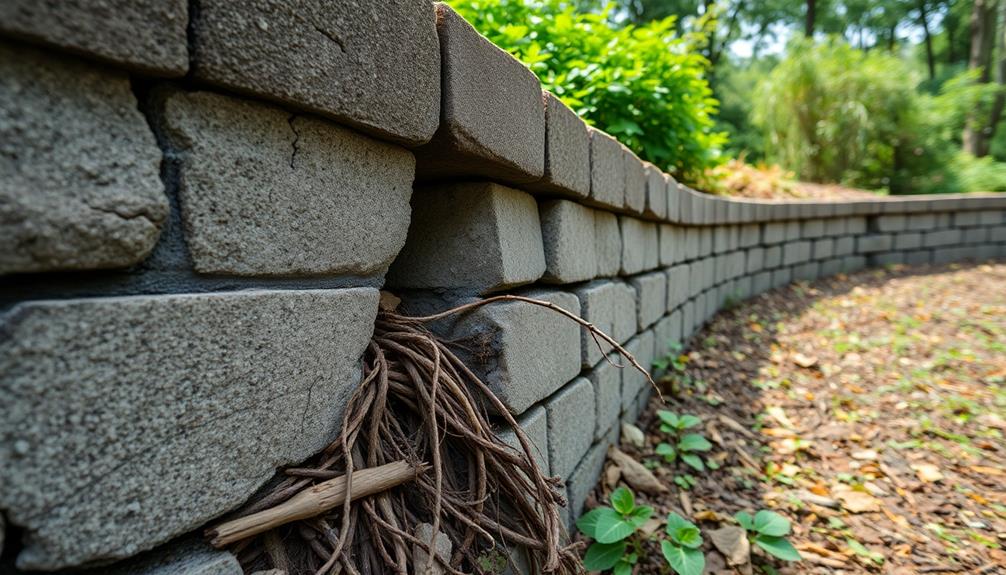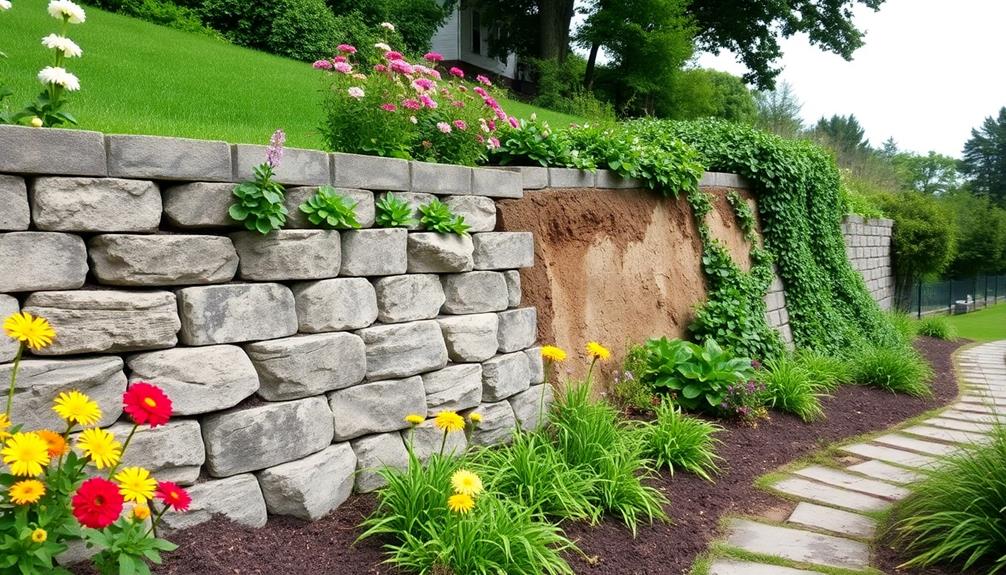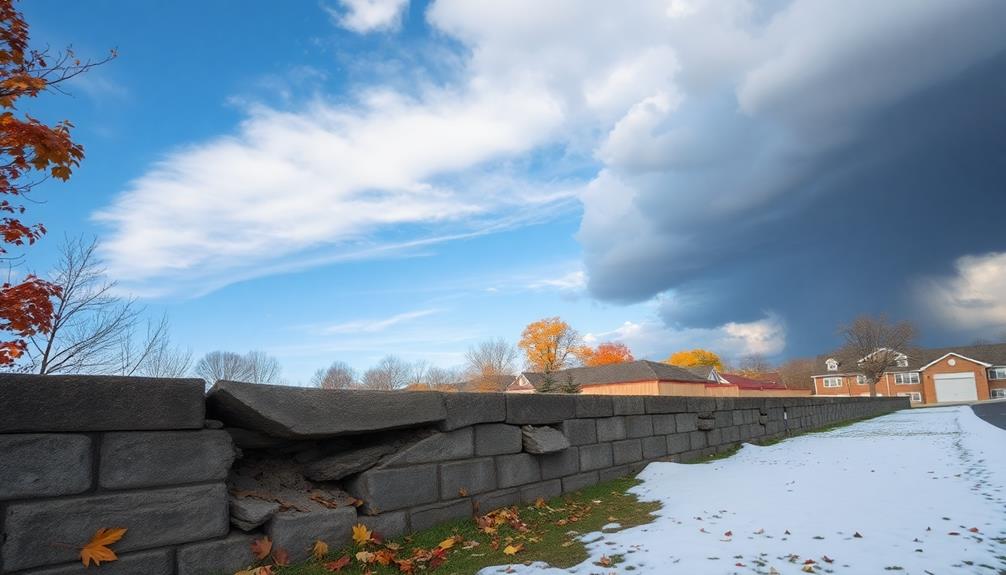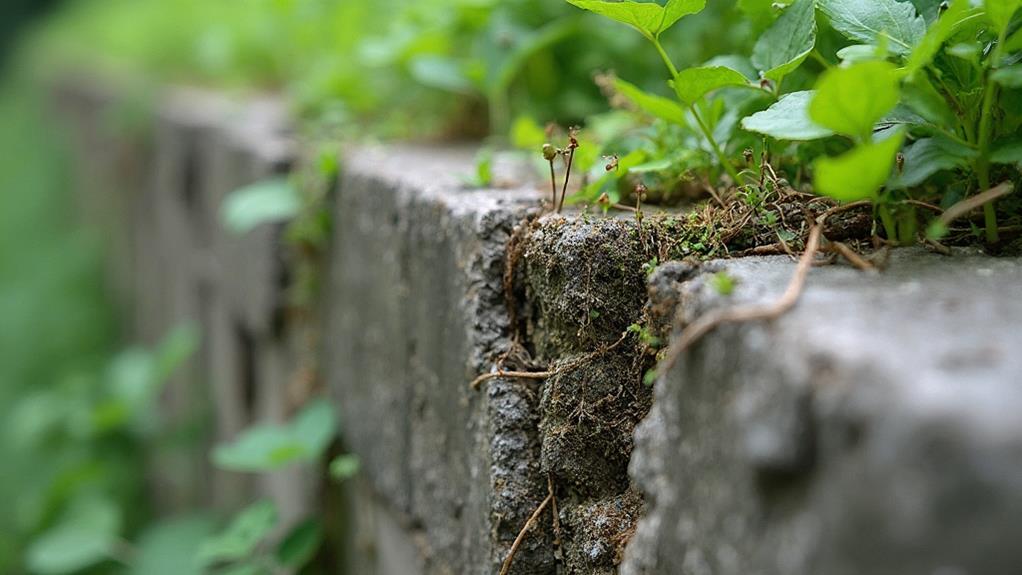Addressing retaining wall issues early is essential to maintaining structural integrity and ensuring safety. Common problems such as inadequate drainage and improper design can lead to hydrostatic pressure buildup, causing wall tilting, cracking, and eventual failure. Early identification of these issues allows for timely interventions, halting progression into significant structural defects and thereby preventing costly repairs. High-quality materials and proper drainage systems are crucial in prolonging the wall's lifespan. Seasonal weather impacts, such as freeze-thaw cycles, further stress materials, underscoring the need for prompt action. By taking proactive measures now, you safeguard your property's stability and value long-term.
Table of Contents
ToggleWalls Contractor Highlights
- Timely addressing of issues lessens future repair costs and prevents extensive, costly repairs or replacements.
- Early intervention secures wall stability, averting the progression of minor problems into major complications.
- Prolonged lifespan results from preemptive remediation, reducing the frequency of necessary repairs.
- Ensuring the safety of residents and visitors by maintaining secure retaining walls and preventing hazards.
- Early management enhances property value by preserving the wall's aesthetics and functionality, improving marketability.
Definition of Retaining Wall Issues

Retaining wall issues often stem from a range of common problems such as inadequate drainage, improper wall design, or poor construction materials. The significance of using quality materials, such as boulders, for their long-lasting and cost-effective benefits cannot be overstated.
These issues may manifest as signs of structural damage including visible cracks or lean in the wall. They are typically indicative of underlying causes of deterioration, such as water saturation, soil erosion, or significant settlement due to shifting earth pressures. Understanding these factors is vital for identifying potential weaknesses early on and implementing effective remediation measures to guarantee the structural integrity of retaining walls.
Common Retaining Wall Problems
When constructing a retaining wall, understanding common problems can aid in preventing costly repairs and structural failures. A prevalent issue is inadequate drainage, which can lead to water accumulation behind the wall, causing hydrostatic pressure that undermines structural integrity. Ensuring proper drainage systems, including weep holes or gravel layers, is crucial in alleviating this pressure and extending the wall's lifespan.
Another frequent concern is poor construction techniques. The use of substandard materials or improper installation can weaken a wall, making it susceptible to shifting and collapse. Employing skilled professionals who adhere to engineering standards is vital in maintaining wall stability and preventing premature deterioration.
Soil composition also plays a critical role, as different types require specific design considerations. Expansive clay soils, for instance, can exert additional forces on the wall, demanding a tailored structural approach. Understanding the geotechnical properties of the site is essential in designing retaining walls that can withstand local environmental conditions.
Moreover, vegetation placement near retaining walls can exacerbate problems. Roots from large trees may penetrate the wall structure, leading to cracks and displacement. Careful planning of landscape elements is crucial to ensure that plant growth does not compromise the wall's effectiveness.
Signs of Structural Damage
Identifying signs of structural damage in retaining walls is essential for maintaining their stability and effectiveness. Recognizing these indicators early allows property owners to engage with a community of experienced professionals who can provide solutions before minor issues escalate into significant structural challenges.
Among the distinctive signs to observe is the appearance of cracks, whether horizontal, vertical, or stepped, which could suggest a compromise in the wall's integrity. Uneven or bulging sections of the wall may indicate that internal pressure is overwhelming its capacity, threatening its foundational support.
Moreover, any noticeable tilting or leaning of the wall should prompt immediate attention, as this could be a precursor to complete failure. Water seepage or pooling around the base of the wall may erode materials and weaken the structure, signaling an issue that needs timely remediation. Also, the presence of displaced retaining wall blocks or a misalignment of the wall's elements could reflect hidden instability within the construction.
Being vigilant about these signs invites a shared responsibility among community members and professionals, fostering an environment where maintaining safety and durability of properties becomes a collective endeavor, ensuring the well-being and integrity of shared spaces.
Causes of Deterioration
While recognizing signs of structural damage sets the stage for timely intervention, understanding the causes of deterioration in retaining walls is fundamental to preventing ongoing issues. A myriad of factors can contribute to the weakening and eventual failure of these critical structures, which if unaddressed, can lead to costly repairs and potential safety hazards.
Among these factors are issues that often arise from environmental conditions, material fatigue, or improper construction practices.
Several common causes of deterioration are:
- Hydrostatic Pressure: Accumulation of water behind the wall can increase lateral pressure, leading to cracks or even complete failure. Effective drainage systems are essential to reduce this pressure.
- Soil Erosion: Loss of supporting soil can undermine the structure's stability, especially in poorly compacted or loose soils.
- Material Degradation: Exposure to harsh weather conditions, chemical erosion, or physical wear and tear can deteriorate construction materials, such as concrete or timber, over time.
- Foundation Settlement: Improperly constructed foundations can settle unevenly, affecting the wall's alignment and stability.
Benefits

Implementing a well-constructed retaining wall can markedly lessen future repair costs by effectively managing soil erosion and water drainage, thereby safeguarding the structural integrity of surrounding areas.
Additionally, a properly designed wall utilizing high-quality materials such as granite or limestone guarantees that the structure can withstand various weather conditions and meet building code requirements.
A properly designed and maintained retaining wall not only enhances the aesthetic appeal and overall value of a property but also plays an indispensable role in stabilizing the landscape, ensuring long-term safety and durability.
With these benefits in mind, property owners are urged to ponder the strategic installation of retaining walls as a proactive measure to protect their investment and maintain a secure environment.
Prevent Costly Future Repairs
Preventing costly future repairs of retaining walls is a strategic advantage that offers substantial financial and structural benefits. Timely intervention guarantees the longevity and stability of the retaining structures, averting the extensive costs associated with major repairs or replacements. By addressing potential issues early, homeowners and property managers can shield themselves from unforeseen financial burdens and disturbances to their daily lives.
Developing an awareness of the signs of distress in retaining walls is pivotal for those who wish to safeguard their investments and maintain the integrity of their properties. Initiating timely inspections and remedial actions can halt the progression of minor issues into severe complications, offering peace of mind through proactive measures.
Consider the following advantages of preemptive maintenance:
- Prolonged Lifespan: Addressing issues early enhances the structural longevity, reducing the frequency of repairs.
- Safety: Early interventions guarantee that retaining walls remain secure, preventing potential hazards to residents and visitors alike.
- Cost Efficiency: Focusing on minor repairs as they arise is noticeably less expensive than undertaking large-scale repair projects later.
- Operational Continuity: Tackling issues when they are manageable prevents disruptions associated with more extensive repairs.
Recognizing the value in prevention strengthens community bonds by promoting safe and cost-effective property management practices.
Enhance Property Value
A well-maintained retaining wall significantly enhances property value by improving both aesthetics and functionality. Such walls not only lend visual appeal with their diverse range of design possibilities—from elegant stonework to sleek and modern textures—but they also introduce practical benefits that prospective buyers find irresistible. In an ever-competitive real estate market, properties endowed with thoughtfully crafted retaining walls often stand apart.
The architectural charm of a well-constructed retaining wall harmonizes with the natural landscape, creating cohesive outdoor spaces that invite communal gatherings and serene retreats. These elements of aesthetic allure engender a sense of pride and belonging among residents, fostering a welcoming environment that appeals to potential buyers who value community and connection.
Moreover, the adaptability of retaining walls allows them to accommodate varying terrain, demonstrating both innovation and care in property maintenance. This facet underscores property owners' commitment to quality, consequently engendering trust among prospective buyers. When retaining walls are addressed promptly and expertly maintained, they reflect positively on the entire property, ultimately increasing its marketability.
Improve Landscape Stability
Integrating retaining walls into the landscape dramatically enhances the stability of the surrounding terrain by mitigating soil erosion and managing water flow effectively. These structural elements are critical in maintaining the integrity of the site's topography, which is particularly beneficial for residents within sloped environments where precipitation can lead to destabilization. By considering these factors, homeowners and property managers can foster a safer and more aesthetically pleasing space.
Retaining walls contribute to landscape stability by offering practical solutions, including:
- Erosion Control: By holding soil in place, retaining walls prevent the loss of topsoil, preserving the fertility and appearance of gardens and lawns.
- Water Management: Designed as part of an integrated drainage system, retaining walls ensure sufficient water flow, reducing the risk of flooding while providing moisture where it's beneficial.
- Tiered Landscaping: Transform steep slopes into functional terraces, creating usable outdoor spaces for communal activities and increasing interaction among occupants.
- Aesthetic Enhancement: Besides their utility, retaining walls can also be designed to complement architectural styles, enhancing both the natural beauty and structural cohesiveness of the property.
These solutions not only cultivate a strong and stable environment but also foster community belonging by creating a harmonious and well-maintained landscape shared by all.
Ensure Safety and Durability
To guarantee both safety and durability, retaining walls must be designed and constructed with meticulous attention to engineering principles and materials selection. The very essence of a community's shared spaces and private landscapes depends on the integrity of these structures.
Properly engineered retaining walls are pivotal in preventing soil erosion and landslides, thus safeguarding both the property and its inhabitants. The selection of high-quality materials, such as reinforced concrete or treated timber, is crucial, as these materials provide the necessary strength and resilience against environmental forces.
In addressing retaining wall issues at their onset, residents and community planners alike contribute to a sense of security and continuous enhancement of their surroundings. Early intervention allows for the implementation of necessary reinforcements, be it through installing proper drainage systems or ensuring adequate wall height and thickness.
Such action not only averts potential structural failures but also extends the lifespan of the wall, embodying a commitment to enduring safety.
Moreover, understanding and applying the principles of good design and construction creates an environment where individuals feel connected to their community, affirmed by the reliable infrastructure that underpins their shared and private spaces.
Seasonal Weather Impact Insights

Understanding the impact of seasonal weather variations on retaining walls is critical for maintaining their structural integrity, as the interplay between environmental factors and construction materials can catalyze issues such as soil erosion and physical stress. The table below delineates key environmental factors with their corresponding effects, emphasizing the nuanced dynamics that arise with temperature and precipitation changes. By analyzing these insights, one can anticipate potential hazards and implement strategies to mitigate weather-induced damage to retaining structures.
| Environmental Factor | Effect on Retaining Walls |
|---|---|
| Rainfall | Accelerated soil erosion |
| Freeze-Thaw Cycle | Structural weakening |
| Temperature Fluctuation | Stress on material cohesion |
Rainfall and Soil Erosion
Frequent and intense rainfall episodes, characteristic of certain seasonal weather patterns, can substantially exacerbate soil erosion, posing considerable challenges to the integrity of retaining walls. When rainwater inundates the soil, it increases the weight exerted on these structures, which are meticulously designed to support specified loads. This excess water, coupled with the erosive force it carries, can eventually lead to degradation, shifting, or even failure of retaining walls.
For a community valuing security and permanence, understanding the nuanced impacts of rain-induced soil erosion is imperative. Continuous engagement with these issues guarantees a robust approach to their mitigation and protection.
Key aspects to ponder include:
- Effective Drainage Systems: Installing or maintaining efficient drainage systems can redirect water flow and alleviate hydrostatic pressure on retaining walls.
- Vegetative Solutions: Pursuing vegetation planting can stabilize the soil and reduce erosion rates via root systems that bind the earth together.
- Regular Inspections: Consistent evaluations confirm early detection of deterioration, enabling timely intervention and maintenance.
- Reinforcement Technologies: Employing advanced structural reinforcements can enhance wall strength against intense rainfall events.
Addressing these elements can foster a sense of collective responsibility and resilience, reinforcing the trust in shared spaces.
Freeze-Thaw Cycle Effects
The freeze-thaw cycle, a recurrent phenomenon in regions with fluctuating temperatures, poses significant risks to the structural integrity of retaining walls. As temperatures drop, moisture within the soil and retaining wall materials can freeze, causing expansion. When temperatures subsequently rise, the ice melts, and moisture contracts. This repeated expansion and contraction process can precipitate the development of cracks and fissures in both the wall and the surrounding earth. Over time, these small imperfections can widen, compromising the wall's stability and leading to potential failure.
Retaining walls, by their nature, must withstand significant lateral earth pressure. The freeze-thaw cycle exacerbates this pressure by potentially altering the soil's density and cohesion. During thaw periods, the excessive water content can saturate the soil behind the wall, adding extra weight and making it more susceptible to movement. This cycle can also cause displacement or weakening of the mortar and materials composing the wall.
Communities situated in vulnerable climatic zones must prioritize early recognition and addressing of these impacts to prevent costly repairs and maintain the safety of their surroundings. By understanding the implications of the freeze-thaw cycle, collective action can reinforce shared spaces and safeguard structural investments.
Temperature Fluctuation Stress
Temperature swings are a formidable adversary to the durability of retaining walls. The persistent expansion and contraction caused by temperature fluctuations can subtly yet profoundly impact structural integrity, often leading to premature deterioration if not addressed promptly.
Seasonal changes bring about a cycle of contraction and expansion for every material involved in the construction of retaining walls. Over time, these stresses manifest as cracks, misalignments, or even complete structural failure.
Homeowners invested in community and well-being must vigilantly guard their spaces against such issues. Addressing temperature fluctuation stress proactively can guarantee that your retaining walls remain strong and enduring amidst changing climatic conditions.
Consider the following:
- Inspection: Regular examinations can identify early signs of temperature-induced wear.
- Material Selection: Opt for materials known for resilience against temperature variations.
- Sealants: Utilize appropriate sealants to minimize moisture ingress, which exacerbates thermal stress.
- Drainage Systems: Certify effective drainage to prevent water accumulation, which can intensify contraction and expansion cycles.
Integrating these strategies into your maintenance routine not only fortifies the retaining walls but also fosters a sense of collective accountability for maintaining a stable and secure environment within the community.
Walls Contractor FAQ
What Are Common Signs of Retaining Wall Failure?
Common signs of retaining wall failure include visible cracks, leaning or bulging structures, water seepage, and soil erosion. Monitoring these indicators fosters a proactive approach, cultivating a sense of responsibility and unity within the community for structural integrity.
How Can Retaining Wall Issues Affect Property Value?
Retaining wall issues can drastically decrease property value by undermining structural integrity and aesthetics, potentially leading to costly repairs. Addressing these problems fosters community investment and demonstrates ownership pride, enhancing both immediate and long-term property appeal.
What Professionals Should Be Consulted for Retaining Wall Repairs?
For retaining wall repairs, consult structural engineers, geotechnical experts, and experienced contractors. Collaborating with these professionals guarantees integrity, safety, and compliance, fostering confidence and trust within the community of property owners and stakeholders invested in maintaining property value.
Are There Cost-Effective DIY Solutions for Minor Retaining Wall Issues?
Exploring cost-effective DIY solutions for minor retaining wall issues can be empowering, enabling homeowners to contribute to preservation efforts. Simple tasks, like vegetation management and drainage improvement, can be achieved independently, fostering a harmonious living environment while ensuring structural integrity.
How Quickly Should I Address Retaining Wall Drainage Problems?
Addressing retaining wall drainage problems should occur immediately to prevent further structural compromise. Prompt action fosters community trust and guarantees safety, maintaining both individual property value and neighborhood integrity in the collaborative landscape of communal development and preservation.







